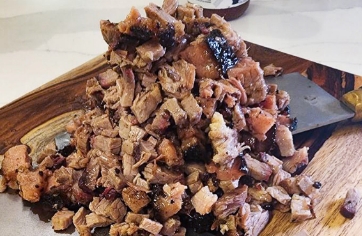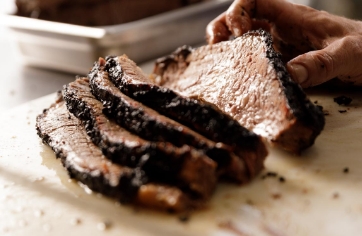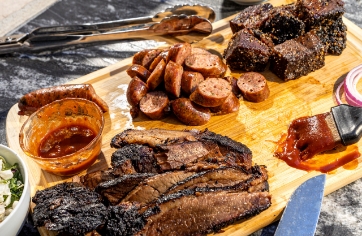The Keys to Smoking a Brisket
In part 6 of our BBQ & A with our Pitmasters and Chefs, Tim McLaughlin and Damian Avila, we unpack many of the key elements of smoking a Central Texas style brisket.
Background
Spend enough time researching the topic of how to smoke a great brisket and you'll quickly find that there are a lot of different opinions. While most agree that the cooking temperature should be in the range of 225° to 275° F, opinions differ as to if, when and how one should wrap the brisket, when and with what to spritz the brisket...or whether these steps are even necessary.
BBQ Student: Let's start with what temperature you use to cook your brisket?
Tim: While most Texas BBQ use Low 'n Slow smoking techniques, we use a Really Low 'n Slow method and typically cook at 225° F. This is the temperature that works best for the briskets we use (untrimmed, 16-17 pound briskets wet-aged for over 40 days), the rub we use (which includes a little white sugar), the smokers we use and our overall process. The goal for pitmasters is to understand all of the variables in their process so they can determine the temperature that works best them.
BBQ Student: Do you cook them fat-side up or fat-side up?
Tim: Surprisingly to me this is actually a controversial topic in the world of BBQ...Not as much as whether to wrap or not...but definitely one in which some people have strong opinions.
Obviously, we want that fat on top to separate and drop down into the meat so we (like most Central Texas BBQ restaurants) cook fat-side up.
BBQ Student: I'll refer people back to these topics.
The Art & Science of Smoking a Brisket
The Importance of Cooking a Brisket Fat-Side Up
Tim: Sounds like a good plan.
BBQ Student: When do you first check on it and do you spritz it when you check?
Damian: Make sure you don't open your smoker every 2 hours or so just to see if it's cooking or changing colors. Every time you open the door of your smoker, the heat escapes and the brisket contracts. We recommend letting them cook for about 8-10 hours before checking on them.
Tim: And we don't spritz them. In fact, we don't introduce any liquid into our process. We don't want to replace fat with water. So, we don't spritz them, we don't use water pans and we don't wrap our briskets.
BBQ Student: Really. You said before that "not wrapping" is pretty controversial.
Tim: Yeah. And I don't really understand why. It's not like Central Texas pitmasters were wrapping briskets. I think it's a newer process that was made popular by Aaron Franklin and the competitive BBQers that had time constraints.
Obviously, you can create a moist brisket by steaming it in foil or butcher paper, but you're replacing fat with brisket-flavored-water. In our opinion, this is bad because when it comes to beef, the mouth equate moistures with fat. So, we don't want to replace any of this fat with water. We want to get the fat into the brisket, not water. So we never put a water pan in our smokers because we're not looking to steam our briskets and we never wrap them because we do not want that fat, fat replaced with water.
BBQ Student: This sounds pretty complex. Why don't we stop there and cover this topic separately.
Ship Crossbuck’s Central Texas Style BBQ Nationwide

Chopped Brisket
Served in convenient oven-safe, vacuum-sealed, 1 lb. bags.

Sliced, Half or Whole Brisket
Served in convenient oven-safe, vacuum-sealed, bags.

Samplers and Gift Packs
Central Texas Style Brisket + other Crossbuck favorites.
